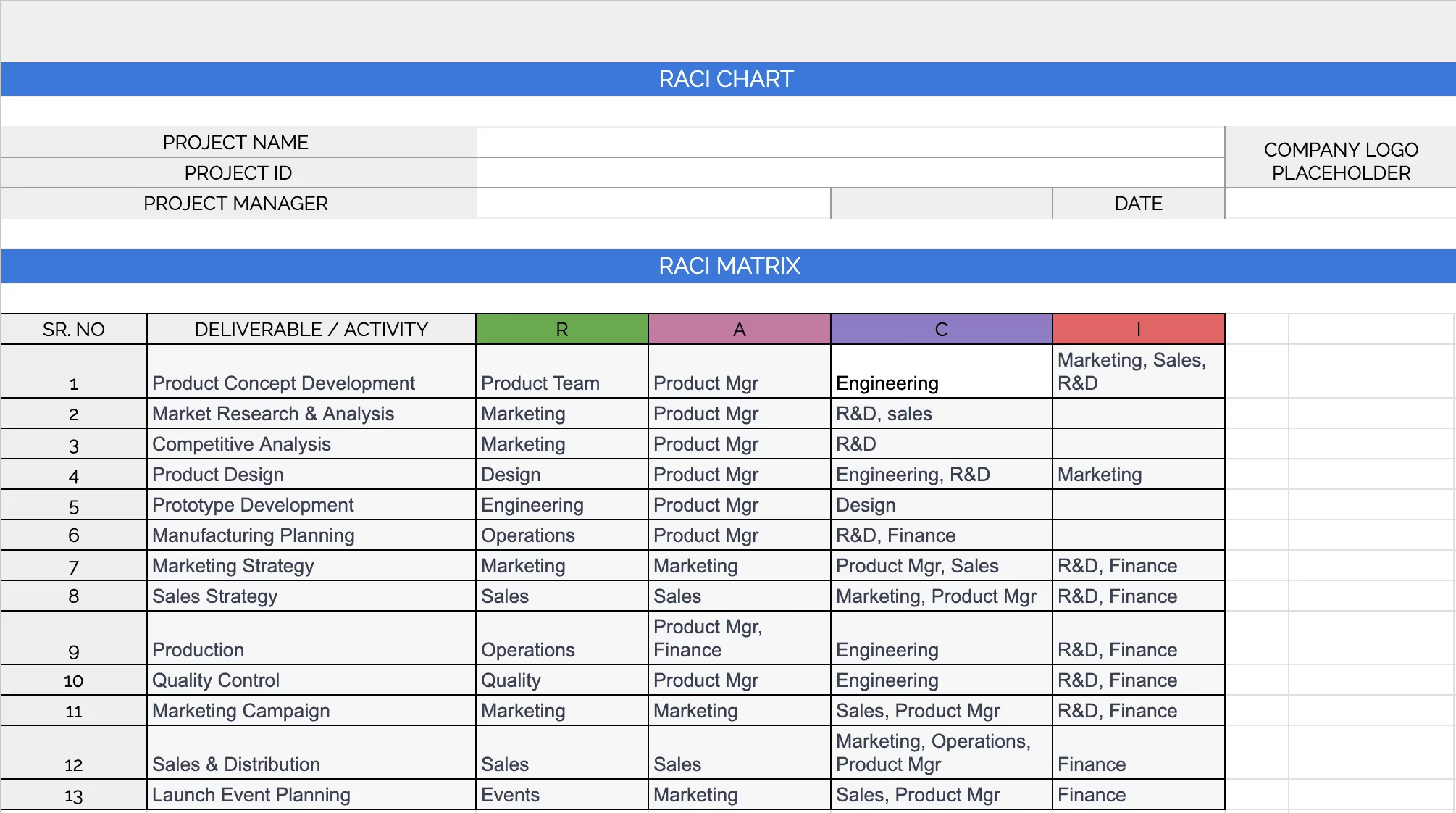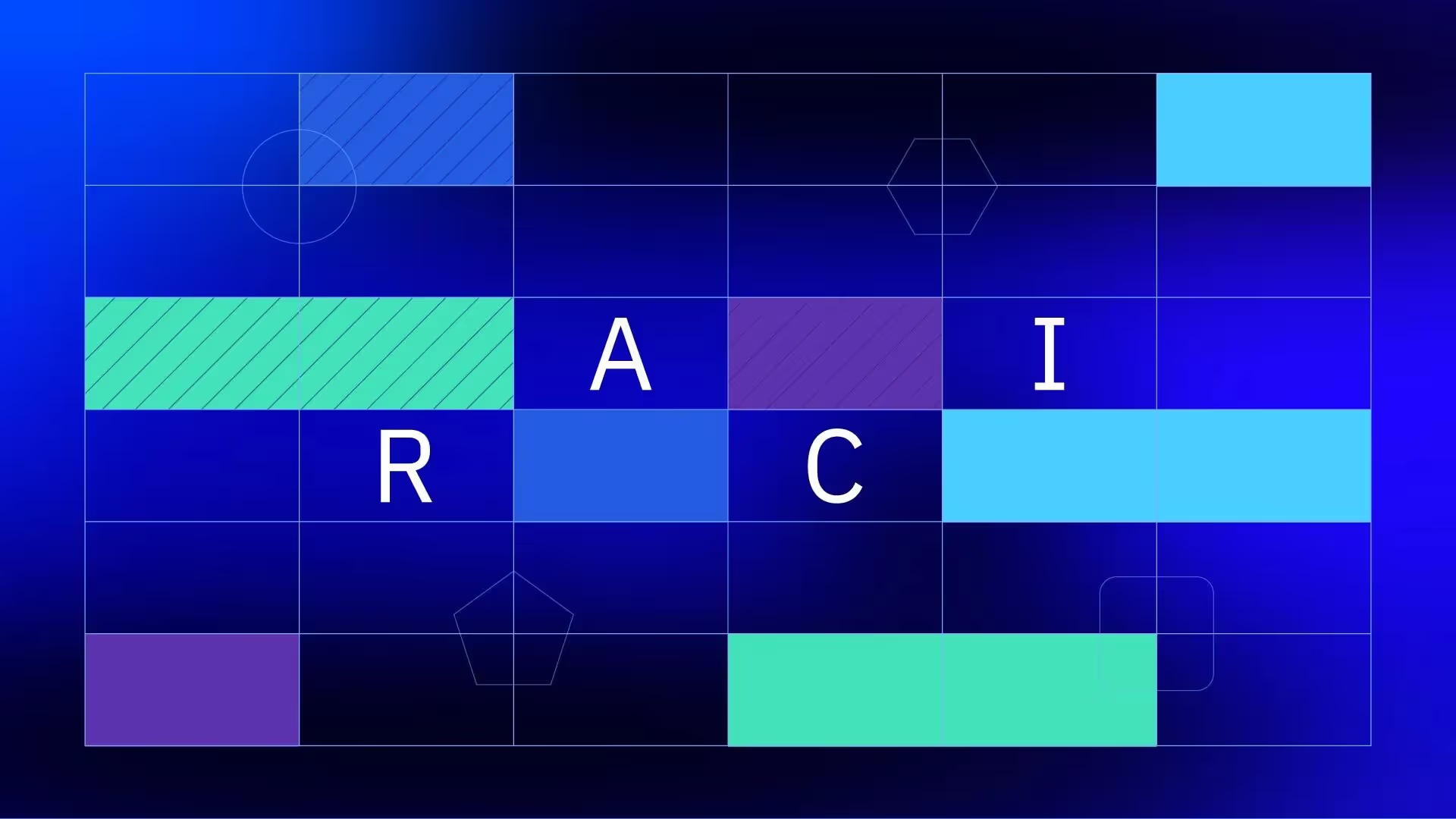Related reading
- How to Make A RACI Chart for A Project [Free Template]
- How to write an effective project mission statement
- How to nail your project delivery [free template]
- How to create a project communication plan [free template]
Picture this: you're sitting at your desk, feeling the pressure build as the countdown to a huge product launch inches closer.
The anticipation is building, but unfortunately, so is the confusion and chaos within your team. Sound familiar? Well, it's time to banish those groans of frustration into oblivion as we delve into the world of RACI charts. This game-changing tool is all about clarifying roles and enhancing cross-functional collaboration in your team. So, grab a cup of coffee (green tea for those who are a little health conscious), and let's explore how RACI charts are effective for cross-functional collaboration.
The importance of defining and assigning roles and responsibilities in cross-functional collaboration
Cross-functional collaboration is when professionals from different areas/members from multiple teams come together to work on a project. It is an approach that harnesses a diverse set of skills to drive innovative and creative solutions.
However, it also presents its own set of challenges.
The challenges of cross-functional collaboration
A common issue in cross-functional collaboration is the lack of clarity regarding roles and responsibilities.
Without clear assignment and definition of tasks, several challenges can arise:
- Miscommunication: Uncertainty about roles can lead to miscommunication, resulting in project delays or mistakes.
- Overlapping responsibilities: Without clear delegation, two or more team members may assume responsibility for the same task, leading to redundancy and wasted effort.
- Accountability issues: When roles are not clearly defined, it can be difficult to hold individuals accountable for their tasks or to know whom to approach for project updates or clarifications.
Effective cross-functional collaboration requires clear communication and coordination among team members from different departments. One vital aspect of this process is defining and assigning roles and responsibilities.
And this is where a RACI chart can help.
Introducing the RACI chart
What is a RACI chart, and how does it work?
A RACI chart is a visual document that clearly maps the roles and responsibilities of every project team member. RACI stands for Responsible, Accountable, Consulted, and Informed.
The chart is typically laid out in a matrix format, where tasks, deliverables, or decisions (on the left) are linked with the individuals or teams (across the top row).

Within the intersections of tasks and teams, one of the RACI roles is indicated, defining the level of involvement for each team member in that specific task:
- "Responsible" refers to the person who actively works on the task.
- "Accountable" identifies the individual who has ownership and ultimate decision-making authority for the task.
- "Consulted" is the role that provides advice and input.
- Those who are "Informed" simply receive updates on the task's progress.
The benefits of using a RACI chart for cross-functional collaboration
By implementing a RACI chart for cross-functional collaboration, teams can experience several advantages that enhance communication and streamline project workflow.
- It helps the project lead manage team roles and responsibilities efficiently, eliminating the risk of assumptions and confusion.
- It ensures that every team member is aware of their responsibilities, leading to increased accountability.
- It clearly stipulates who needs to be consulted or informed, which can improve communication and decision-making processes.
- It fosters better team collaboration and synergy by providing transparency on who does what, reducing duplication of work and conflicts.
- The use of a RACI chart can often result in a more productive team environment and successful project outcomes because it clarifies roles and workflows.
Alternatively, you can also try Rocketlane's free RACI template for your projects!
Streamlining workflows with a RACI chart
A RACI chart is instrumental in streamlining organizational workflows. It reduces the chances of misunderstanding and increases productivity.
Whether you are managing a small project or a large-scale initiative, the RACI chart provides clarity and accountability. By clearly defining the roles and responsibilities of team members, you can eliminate confusion and prevent tasks from falling through the cracks.
1. Clarifying team roles and expectations
By clearly defining who is Responsible, Accountable, Consulted, and Informed for each task or decision, a RACI chart ensures that everyone on the team understands their role and responsibilities. It also helps prevent duplication of efforts and minimizes the chances of tasks falling through the cracks. When team members have a clear understanding of their roles and expectations, they are better equipped to collaborate effectively, resulting in smoother workflows, improved outcomes, and a more harmonious working environment.
2. Identifying gaps and overlaps in responsibilities
A RACI chart also helps in identifying gaps where no one has been assigned responsibility for a task and overlaps where multiple people are performing the same task. This way, unnecessary redundancy can be removed from the process, and unassigned tasks can be given the attention they require, thereby adding efficiency to the workflow.
3. Allocating resources effectively
Through a RACI chart, a clear picture of the role allocation and the workload of all team members emerges. This visibility into tasks and responsibilities aids in the efficient allocation of resources. If a team member is overloaded with "Responsible" tasks, resources can be reallocated to create balance and prevent burnout. Conversely, underutilized resources can be spotted and reallocated to areas where they are most needed.
Rocketlane's resource allocation feature enables teams to allocate resources effectively, ensuring that everyone understands their roles and responsibilities, leading to smoother cross-functional collaboration and improved overall productivity.
Enhancing communication and fostering a more efficient team environment using a RACI chart
The use of a RACI chart can significantly improve communication and collaboration within a project team. By outlining the roles and responsibilities of each team member, a RACI chart addresses common project management challenges and provides a roadmap for the successful execution of tasks.
Here are some ways by which a RACI chart can enhance collaboration and communication in a team.
1. Enhancing transparency and accountability
The RACI chart clearly defines the roles and responsibilities of team members involved in a project, making it easier to track progress and assign tasks. When responsibilities are stated explicitly, each team member knows what they are accountable for. They can own their tasks, drive them forward, and be held accountable for the outcomes. This sense of ownership encourages active participation and eliminates ambiguity. A RACI chart enhances transparency by providing a visual representation of everyone's contributions, promoting collaboration and leading to more successful project outcomes.
2. Encouraging teamwork and collaboration
The RACI chart also fosters teamwork, as it provides a comprehensive overview of all the tasks and who is responsible for what. This clarity in delegation promotes a sense of interdependency, where team members understand that everyone has a crucial role to play in the successful execution of the project. It encourages collaboration as each individual knows who to consult or inform about decisions, updates, or changes.
3. Reducing conflicts and misunderstandings
Most conflicts in cross-functional collaboration arise due to ambiguity about roles, tasks, or responsibilities. A RACI chart eliminates such misunderstandings by clearly defining these aspects. By setting expectations right at the beginning of the project, the RACI chart aids in reducing conflicts, misunderstandings, and overlapping of tasks. This paves the way for a harmonious work environment and successful project outcomes.
4. Promoting collaboration and knowledge sharing
A RACI chart is not just about assigning roles but is also an effective tool for promoting collaboration and knowledge sharing. By clearly outlining who is responsible for what, team members understand who they need to collaborate with on specific tasks. This prompts active interaction and the sharing of expertise, boosting the overall efficiency and effectiveness of the project.
Challenges of cross-functional RACI chart
The cross-functional RACI chart is an incredibly useful tool for organizations to clarify roles and responsibilities across departments and teams. However, it's not without its challenges.
Here are some common challenges you might face when implementing a RACI chart for cross-functional collaboration.
1. Identifying the right stakeholders: The success of a cross-functional RACI chart depends on accurately identifying and involving all relevant stakeholders. This can be a difficult task, as some stakeholders may not be immediately apparent, and their impact on a given process may be easily overlooked.
2. Balancing conflicting priorities: In a cross-functional environment, departments or teams often have different priorities and objectives. Aligning these conflicting priorities to ensure smooth collaboration can be a significant challenge. It requires strong communication and negotiation skills to find common ground and ensure everyone's objectives are met.
3. Maintaining up-to-date information: A cross-functional RACI chart needs to be continuously updated to reflect changes in roles, responsibilities, and processes. This maintenance task can be challenging, particularly in large organizations or those with frequent changes in team structures. Failure to keep the chart up-to-date can result in confusion and miscommunication among team members.
4. Overcoming resistance to change: Implementing a cross-functional RACI chart inherently involves shifting the way people think and work. Resistance to change can be a significant obstacle, particularly if employees are accustomed to established ways of doing things. Investing time and effort in change management and ensuring proper training can mitigate this challenge.
Despite these challenges, the benefits of implementing a cross-functional RACI chart, such as improved collaboration and clarity of roles, outweigh the difficulties. Addressing these challenges head-on and providing the necessary support will help organizations navigate the implementation process more effectively.
Best practices for implementing a RACI chart
When implementing a RACI chart, it's crucial to apply a few best practices to ensure its effectiveness. These will help in leveraging this tool for improved cross-functional collaboration and robust project management.
To ensure a successful implementation, here are a few best practices to consider.
1. Involving all relevant stakeholders
First and foremost, ensure that all relevant stakeholders are involved in creating the RACI chart. This includes not only team members assigned to carry out the tasks but also those who hold an interest in the project or its outcome. This could include team leads, subject matter experts, project managers, and even external contractors or vendors.
By involving all stakeholders from the beginning, you can gain valuable insights, address any concerns or conflicts early on, and ensure a collaborative approach to assigning roles and responsibilities. This not only improves accountability but also increases the chances of a smooth and successful execution of your project.
2. Keeping the RACI chart up-to-date and accessible
Another crucial best practice is to keep the RACI chart up-to-date and accessible to everyone involved in the project. As project scopes can change and teams can evolve, the RACI chart should be adjusted accordingly. This means adding new tasks, reassessing responsibilities, and maintaining them consistently.
Keeping the chart accessible to all ensures everyone can reference their roles and responsibilities as necessary, allowing for smooth project execution and minimizing confusion and misinterpretation.
3. Monitoring and evaluating the effectiveness of the RACI Chart
Finally, continually monitor and evaluate how effective the RACI chart is in promoting cross-functional collaboration and defining clear roles and responsibilities. Consider conducting regular reviews to check whether designated roles are being adhered to, if communication is improving, and if the project is progressing as planned. This ongoing evaluation – and possible adjustment – keeps the RACI chart relevant and ensures it continues to serve its purpose throughout the project lifecycle.
Harnessing the power of the RACI chart for effective cross-functional collaboration
The RACI chart is more than just a project management tool. It's a powerful resource that enables cross-functional collaboration by providing clarity and structure in terms of roles and responsibilities. This chart helps identify potential bottlenecks or overlaps in responsibilities, enabling teams to resolve them proactively.
If you're looking to improve communication, streamline workflows, and create a more productive team environment, we strongly recommend incorporating a RACI chart into your processes. Not only will it boost your project management capabilities by ensuring team members understand their duties, but it will also enhance teamwork and lead to overall project success.
With Rocketlane, teams can easily create and share RACI charts, ensuring that everyone is on the same page regarding who is responsible, accountable, consulted, and informed for each task. This helps streamline workflows, eliminate confusion or duplication of efforts, and ultimately improve overall efficiency.
Rocketlane also offers collaboration features such as comments and notifications, enabling team members to communicate and coordinate effectively. By leveraging Rocketlane's capabilities, organizations can enhance their cross-functional collaboration and drive successful project outcomes. Try it today!
FAQs
1. What is a cross-functional RACI chart?
A cross-functional RACI chart is a tool used in project management to define and communicate the roles and responsibilities of team members across different functions or departments.
2. What does RACI stand for?
RACI stands for Responsible, Accountable, Consulted, and Informed. It is a framework used to clarify the roles and responsibilities of individuals involved in a project or task.
3. What is the purpose of a cross-functional RACI chart?
The purpose of a cross-functional RACI chart is to clearly define who is responsible, accountable, consulted, and informed for each task or deliverable in a project, ensuring effective collaboration and clarity of roles.
4. How does a cross-functional RACI chart improve project management?
A cross-functional RACI chart improves project management by providing clarity on individual roles and responsibilities, allowing for effective communication, avoiding duplication of efforts, and reducing confusion and disagreements within a team.
5. Can a cross-functional RACI chart be updated or revised during a project?
Yes, a cross-functional RACI chart can be updated or revised during a project as needed. Changes in team composition, task priorities, or project scope may require adjustments to the roles and responsibilities defined in the chart.



















